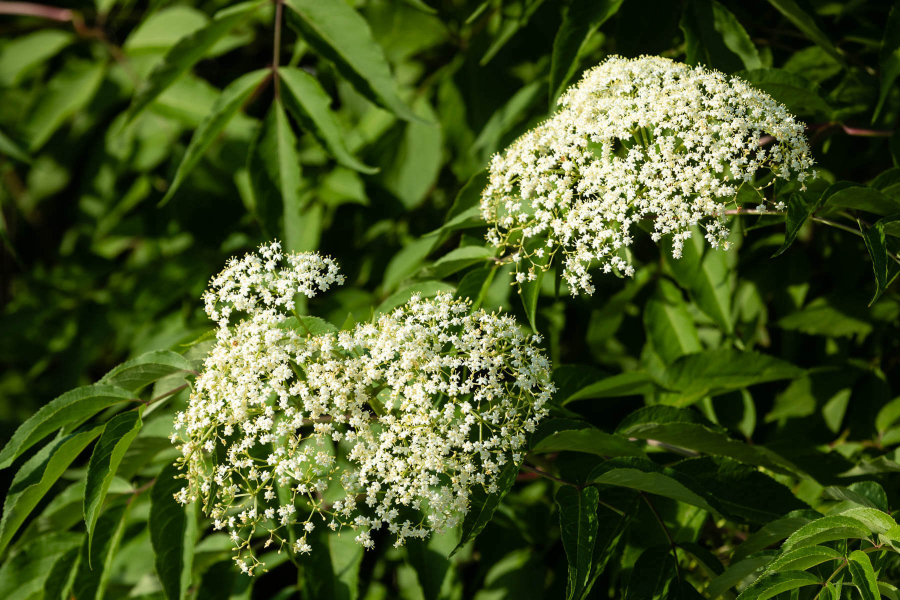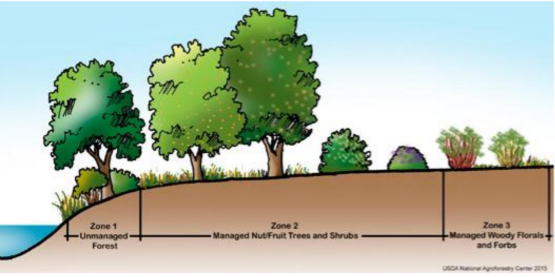What’s in a tree? Oxygen, food, clean water and money

One of the simplest ways to improve a landscape–whether it’s a stream bank, a struggling field or a sunbaked blacktop—is to add plants. We all know trees help the environment. Their leaves capture energy from the sun to feed the tree and in the process, provide us with oxygen. Their canopies shade streams, helping fish and other creatures stay healthy in the cool water. Their roots hold stream banks together, reducing erosion and pollution.
Despite all of these benefits, the Chesapeake watershed is far behind in its goal to increase the number of riparian buffers: a term which refers to trees, shrubs and other plants that grow alongside a waterway. Forest buffers are the water’s last line of defense against pollution that washes off the land.
Most think of riparian buffers as being meant only for environmental improvement and wildlife habitat, but that doesn’t have to be the case. Buffers can be beneficial—and lucrative—for the people that live near them. So why are we so behind on our goal?
To determine possible solutions, the Chesapeake Bay Program’s Scientific and Technical Advisory Committee (STAC) reviewed studies and gathered scientists, farmers and other experts in a 2019 workshop dedicated to new ways to make progress on buffers. The report resulting from this coming-together of experts advises maximizing benefits through multifunctional buffers and market-based approaches.
There's money in that buffer
A multifunctional buffer isn’t just for the birds. Instead of landowners having to decide between helping the environment and profiting off their land, multifunctional buffers let people work with nature and benefit from it by harvesting from the buffer. It is all about rethinking buffers as an income source, finding a market and making the right choice on what to plant.
Forest buffers have been a primary focus in the Chesapeake Bay watershed due to trees’ incredible ability to improve both land and water, but studies reviewed in the workshop suggest that grass buffers can also reduce nutrient and sediment pollution and improve water quality.
To help support functions for both environment and people, the workshop attendees discussed a new multifunction approach to buffers: zones of use.

Zone one, right along the water, would be a no-harvest, traditional forested buffer. Here, birds would thrive undisturbed, the water would be shaded and its quality improved, and it would create excellent views for kayakers and other recreators that would be drawn to the area by its environmental improvements.
Inland would be the harvestable section. There is traditionally tension, particularly in the agricultural sector, between protecting your land and water and the loss of income if crop land were to be turned over to trees. Rethinking buffers as a source of crops reestablishes the time-honored relationship of farmer and nature as partners.
Zones two and three could be interchanged with each other depending on market or flooding conditions, but the principle remains the same. All or most of the trees and shrubs here would provide environmental benefits by reducing nutrient runoff but could also be harvested.
In Zone two, trees continue along with some new shrubs and forbs (herbaceous plants that are not technically grasses). Hazelnut trees, elderberries, persimmons, raspberries and others would provide fruit and nut crops for the harvest, making this a multifunctional managed zone. Here, biodiversity would thrive.
Zone three continues to provide environmental benefits, but switches focus to a different economic angle. In zone 3, native grasses and wildflowers would thrive. This creates a draw for pollinators, which in turn benefit the crops of zone two and the larger property. Plants and shrubs could also be chosen for their ability to attract insects, birds and other biological controls that eat pests, helping to eliminate issues without expensive chemical controls.
The future is out there
Tree, shrub and grass species in these new buffers have tremendous potential in new markets.
One particular plant studied—switchgrass (Panicum virgatum)—offers tantalizing opportunities, both environmental and economic.
Switchgrass is a native grass with a root structure that can routinely be six feet. As these roots grow, they help control erosion and improve the structure of the soil. There is also a growing market demand for switchgrass, as it can be used for alternative energy and the creation of bioeconomies (bioeconomy: one which primarily involves the utilization and conservation of natural resources).
Turned into pellets, switchgrass is an industrial absorbent. When harvested, switchgrass is a solid choice for poultry bedding, erosion control and even as a substrate for growing mushrooms. FDC Enterprises, a company that presented at the workshop, recently used 6,000 acres of switchgrass to power a bioenergy boiler, which was used to generate the heat for a hospital in Virginia.
For the sweeter side of things, berry brambles are a popular option in low-height buffers. Instead of the quick-harvested corn or grain a field may previously have held, thickets of raspberries create an extensive root system and offer a continuous crop of berries, which could even be harvested in the less-intensive but immensely popular “U-Pick” option that attracts community members.
Elderberries, a popular option in buffers for their quick growth and ability to attract pollinators, have a market-in-waiting in the health field. Elderberry has traditionally been used to boost the immune system and is starting to creep into popular products in the pharmacy.
The trees themselves are in the new-crop game as well. Persimmons and hazelnut trees produce direct crops for harvest. Oaks are a largely untapped source for gluten-free flour, and maples can mean new arenas for syrup production. Forests also bring birds and game animals, opening the gate for economic boon from traveling hunters, birders, hikers and other recreational users.
New multifunctional buffers offer big opportunity to improve both the health of the environment and a landowners’ bottom line, but it will take coordination, partnership and innovation to make it happen.
For more on multifunctional buffers and suggestions on partnerships, read the Science and Technical Advisory Committee’s full report, “Establishing Multifunctional Riparian Buffers: How do we accelerate riparian buffer plantings across the Chesapeake Bay with the greatest economic, social and environmental impacts?”

Comments
There are no comments.
Thank you!
Your comment has been received. Before it can be published, the comment will be reviewed by our team to ensure it adheres with our rules of engagement.
Back to recent stories